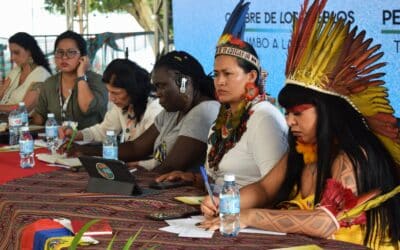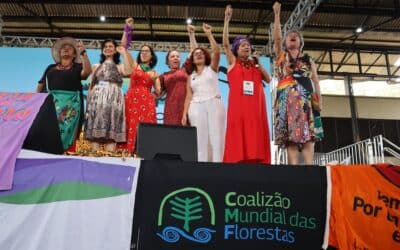Potenciales y riesgos de la Iniciativa para la Restauración del Paisaje Forestal Africano (AFR100)
por Philip Owen, publicado el 25 de octubre de 2022 en germanclimatefinance.de | Las plantaciones comerciales de árboles son una de las principales causas de la degradación de la tierra y no constituyen verdaderos esfuerzos para restaurar los ecosistemas degradados. Alemania, como uno de los principales partidarios de AFR100, debe actuar para excluirlas de la iniciativa.
… continuar en ingles
Across Africa, commercial tree plantations are one of the driving forces of land degradation and all its devastating environmental and socioeconomic consequences. It’s for that reason alarm bells are ringing amongst communities and activists that monoculture tree plantations are being promoted under the African Forest Landscape Restoration Program (AFR100), an Africa-wide initiative aiming to restore 100 million hectares of degraded forest land by 2030.
Launched in 2015 at the Paris Climate Summit, AFR100 aims to mobilise support from national governments, public and private sector partners, international development programs and local communities to restore productivity to deforested and degraded lands and improve livelihoods across the African continent. To date, 32 countries have pledged almost 130 million hectares to the project.
According to the UN Food and Agriculture Organisation (FAO), up to 65% of productive land in Africa is degraded and desertification affects 45% of the continent’s land area. Removing carbon from the atmosphere through restoring forests and other ecosystems is vital to tackling the climate crisis, and initiatives like AFR100 can play an important role in this. Many of the projects associated with AFR100 and the momentum it has created are making highly valuable contributions to landscape restoration. But the initiative is not without its controversies and there are increasing concerns that corporate capture of the programme is leading to an unprecedented expansion of new commercial timber plantations across the continent—the very same industry driving the deforestation and soil degradation the initiative is supposed to be addressing.
Impacts of commercial tree plantations hit communities hard
Communities across Africa know first-hand the devastating effects of monoculture tree plantations. In South Africa’s Kwa-Zulu Natal Province, social and environmental activist Sibongile Mtungwa remembers first noticing the changing landscape as a child. Walking with her grandmother to collect firewood, she recalls neat rows of perfectly planted pine trees where the natural forest had been. Companies had cut the indigenous trees down, she says, and replaced them with monoculture timber plantations.
Sibongile is the director of the Women’s Leadership and Training Program in southern Kwa-Zulu Natal Province. She works predominantly with young women between 12 and 19 in rural areas where many residents rely on small-scale agriculture.
Sibongile laments “as the pain of my heart, and the pain of my community” the land degradation brought on by the soil erosion of the past forty years. The environmental and socioeconomic impacts on local communities, especially women, have been devastating. Many residents have abandoned their eroded and degraded fields, leading to food insecurity, she says: “In the past, when more people were farming their plots of land, there was food, even if there was no money.”
By the time Sibongile was 16, the area under plantations had soared. There was less space for grazing cattle, which were confined to ever-diminishing and fragmented grassland. This led to over-grazing, which leads to soil erosion, she said. It was clear; the soil erosion accelerated with the expansion of timber plantations. South Africa’s timber plantations cover 1.2 million hectares, with nearly 40% of those plantations in KwaZulu-Natal, covering over 5% of the province.
Despite the adverse environmental, social, health and economic impacts, high-impact monoculture plantations are being established under the guise of ‘afforestation’ or ‘reforestation’, including under the AFR100 initiative. These plantations are most often of alien timber species (such as pine, wattle, and eucalyptus) with the primary aim of extracting the maximum amount of biomass. New science proves that timber plantations actually cause carbon emissions due to disturbances to the soils. Only when the forest system stabilises can it sequester carbon, and then it is the ‘living ecosystem’ not the trees alone, that is responsible for carbon sequestration. The more biodiverse, the better the natural ecosystem is at sequestering carbon. Grasslands are also large carbon sinks and play an important role in water retention.
As with the broader impacts of climate change-induced natural disasters, land degradation disproportionately affect poor and vulnerable communities living in rural areas. Women, children, and the elderly are particularly affected, as it is women who bear the primary responsibility of taking care of basic family needs such as the collection of firewood and water, which are hampered by commercial tree plantations and resulting land degradation.
In an interview with Mamadou Diakhite, the Acting Head of the Environmental Sustainability Division at the African Union Development Agency (AUDA-NEPAD), he expressed concern about the spread of monoculture plantations under the guise of restoration. According to Mamadou, NEPAD “totally disagrees with planting monoculture of trees not appropriate to a given location.” However, despite this ideological objection, he acknowledged industrial plantations were among AFR100 programmes, lamenting that with only 10 staff, the secretariat is small “and the continent is huge.”
Plantations play a dubious role in the AFR100
According to the Global Forest Coalition Briefing AFR100: Driving Commercial Plantation Expansion in Africa? “[half] of the 30 participating countries currently have targets involving commercial plantations that fall within or are concurrent with their AFR100 pledges. Put together, these involve over 4.5 million hectares of commercial tree plantation expansion and 770,000 hectares of improved plantation management. This is equivalent to a 91% increase in the land area currently occupied by commercial plantations in Africa.”
This expansion will have devastating impacts on ecological integrity, indigenous diversity and ecosystem services, compromising water and food security for many rural communities. The irony is not lost in the fact that the vast amount of ‘invasive plants’ responsible for soil erosion are a direct result of large-scale timber plantations under ‘afforestation’ initiatives.
South Africa has pledged 3.6 million hectares of land to AFR100. Its published priorities under the initiative include increasing water retention and landscape stability by controlling erosion and combating desertification. It is not clear if South Africa plans to utilise AFR100 funding to establish more commercial tree plantations, as there is very little publicly accessible information on the initiative. Yet, under South Africa’s forest 2030 roadmap, which coincides with the AFR100 implementation phase (2020–2030), there is a 100,000-hectare target for commercial tree plantations.
The only publicly available means of monitoring AFR100 implementation is through the Bonn Challenge Barometer. After two years into the Bonn Challenge and the AFR100 implementation phase, only a handful of countries have reported some progress and South Africa is not one of them. This lack of transparency and accountability makes implementation difficult to monitor.
As a multi-stakeholder initiative with an emphasis on public-private partnerships and leveraging private-sector investment, AFR100 is inherently susceptible to corporate capture. This makes the need for transparency and accountability critical, not only for implementing governments but also for companies and governments from the Global North funding and supporting them.
Germany’s responsibility to act
The German government through its Federal Ministry of Economic Cooperation and Development (BMZ) is the main financial backer of AFR100 whilst Germany-based climate and forestry firms are directly contributing to and supporting the establishment of commercial tree plantations in Africa under the guise of restoration initiatives.
Among the AFR100 technical partners are Europan-based climate consultancies and firms, such as Unique, a ‘forest management and consultant firm’ headquartered in Germany, which promotes and is linked to the setting up of commercial plantations in several African countries, including Madagascar, Kenya, and Mozambique. Unique was recently criticised for its role as both a consultant to government forest restoration efforts and a private-sector forestry company. It has direct investments in plantation projects and advises governments and other institutions to develop industrial tree plantation projects in the name of forest restoration and climate mitigation.
The German government also has a specific responsibility for the initative. BMZ sits on the AFR100’s Management Committee as the only representative of a national government, alongside GIZ, the World Resources Institute, the International Union for Conservation of Nature (IUCN), the Food and Agriculture Organisation (FAO), and the World Bank. Its support for AFR100 falls under its Forest Action Plan, which has invested 2 billion Euros in forest-related projects, including the GIZ-implemented Forests4Future program, which deals with issues related to the Bonn Challenge and other international Forest and Landscape Restoration (FLR)-related initiatives. Forests4Future has so far provided around 4.4 million Euros in support of AFR100, including financing NEPAD, which acts as the AFR100 secretariat, and FLR projects in Togo, Ethiopia, Cameroon, and Madagascar, all of which include tree plantations in their AFR100 pledges.
Addressing land degradation in Africa is central to the global battle against climate change and biodiversity loss. Yet the key to sustainability is diversity. As the African Biomass Working Group so candidly put it: “Monoculture Tree Plantations Are Not Forests!” Monoculture timber is not a solution to, but a cause of land degradation and must not be permitted under the AFR100.
The German government and technical and financial partners of the AFR100 such as Unique must ensure funding and support goes towards genuinely effective efforts that reverse land degradation and deforestation whilst also benefiting rural communities and addressing historical grievances and structural inequalities for marginalised communities, including women.
Guest post by Philip Owen, GeaSphere, South Africa




